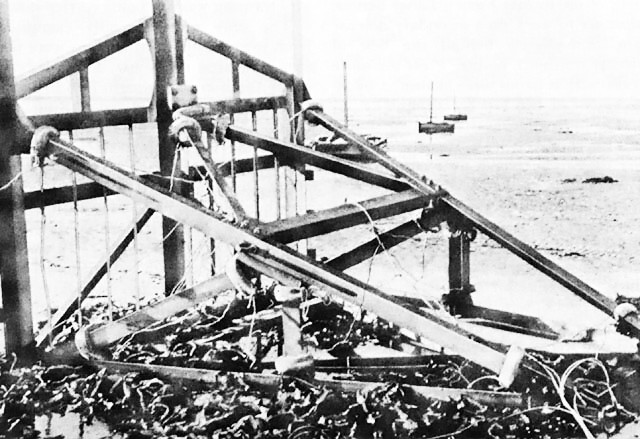Cointet-element on:
[Wikipedia]
[Google]
[Amazon]
 The Cointet-element, also known as a Belgian Gate or C-element, was a heavy steel fence about wide and high, typically mounted on concrete rollers, used as a mobile anti-tank
The Cointet-element, also known as a Belgian Gate or C-element, was a heavy steel fence about wide and high, typically mounted on concrete rollers, used as a mobile anti-tank
Obstacles on the Normandy battlefieldskwlinie.be – A Belgian inventarisation project of the KW line set up in 2009
Fortification (obstacles) Anti-tank obstacles Military history of Belgium during World War II Maginot Line Military equipment introduced in the 1930s {{Fortifications Fortification (architectural elements) Area denial weapons
 The Cointet-element, also known as a Belgian Gate or C-element, was a heavy steel fence about wide and high, typically mounted on concrete rollers, used as a mobile anti-tank
The Cointet-element, also known as a Belgian Gate or C-element, was a heavy steel fence about wide and high, typically mounted on concrete rollers, used as a mobile anti-tank obstacle
An obstacle (also called a barrier, impediment, or stumbling block) is an object, thing, action or situation that causes an obstruction. Different types of obstacles include physical, economic, biopsychosocial, cultural, political, technologic ...
during World War II
World War II or the Second World War, often abbreviated as WWII or WW2, was a world war that lasted from 1939 to 1945. It involved the World War II by country, vast majority of the world's countries—including all of the great power ...
. Each individual fence element weighed about and was movable (e.g. with two horses) through the use of two fixed and one rotating roller. Its invention is attributed to a French colonel (later general), Léon-Edmond de Cointet de Fillain who came up with the idea in 1933 to be used in the Maginot Line
The Maginot Line (french: Ligne Maginot, ), named after the French Minister of War André Maginot, is a line of concrete fortifications, obstacles and weapon installations built by France in the 1930s to deter invasion by Germany and force the ...
. Besides their use as barricades to the entrances of forts, bridges and roads, the heavy fences were used in the Belgian "Iron Wall" of the Koningshooikt—Wavre Line (also known as "Dyle Line") and their re-use as beach obstacles on the ''Atlantic Wall'' defending Normandy from Allied invasion.
History
The Cointet-element formed the main barricade of the Belgian K-W Line, a tank barricade that was built between September 1939 and May 1940. Following tests, the Belgian Army accepted the Cointet-elements in 1936 after slightly altering the design by the addition of eight vertical beams in the front frame to stopinfantry
Infantry is a military specialization which engages in ground combat on foot. Infantry generally consists of light infantry, mountain infantry, motorized infantry & mechanized infantry, airborne infantry, air assault infantry, and m ...
moving through them. On 13 February 1939 and 24 July 1939 the first tenders were called for ten groups of five hundred Cointets each. A total of 77,000 pieces were ordered by the Belgian Ministry of Defence and produced by twenty-eight Belgian companies with 73,600 pieces delivered.
Thousands of Cointets were installed on the K-W Line between the village of Koningshooikt and the city of Wavre to act as the main line of defence against a possible German armoured invasion through the heartland of Belgium, forming a long iron wall. The Cointet-elements were placed next to each other in a zig-zag and connected with steel cables. Near main roads they were fixed to heavy concrete pillars set into the ground to allow local traffic passage. By May 1940 however, due to a relocation programme, the elements did not form a continuous line and thus were easily bypassed by the 3rd and 4th Panzer Divisions.
The Cointet elements were also used as an anti-tank line in a sidebranch of the K-W Line, which was meant to defend the southern approaches to Brussels
Brussels (french: Bruxelles or ; nl, Brussel ), officially the Brussels-Capital Region (All text and all but one graphic show the English name as Brussels-Capital Region.) (french: link=no, Région de Bruxelles-Capitale; nl, link=no, Bruss ...
. This line branched off the main line in Wavre and ran from there to Halle Halle may refer to:
Places Germany
* Halle (Saale), also called Halle an der Saale, a city in Saxony-Anhalt
** Halle (region), a former administrative region in Saxony-Anhalt
** Bezirk Halle, a former administrative division of East Germany
** Hall ...
and on to Ninove, where it ended on the banks of the Dender.Tuyteleers, Wim, ''De IJzeren muur bezuiden Brussel. Ninove-Halle-Waver'', 2020, 176 p.
After the German victory in Belgium on 28 May 1940, the Belgian Gates were reallocated across Europe to serve as barricade elements on roads, bridges and beaches. The Germans gave it the name ''C-element''. Large numbers of gates were brought to Normandy during the construction of the '' Atlantikwall'' to be used with the other varieties of beach obstacles. Instead of connecting them, the Germans used them singly next to other items, especially at the low tide line. They were also put on the dikes next to bunkers. Notes from 1944 cite the placement of 23,408 Cointets over of coastline. With many more still present in Belgium after D-Day, the Allies had great difficulty passing them in the last months of the war.
See also
* Cheval de frise * Czech hedgehog * Dragon's teethReferences
External links
Obstacles on the Normandy battlefields
Fortification (obstacles) Anti-tank obstacles Military history of Belgium during World War II Maginot Line Military equipment introduced in the 1930s {{Fortifications Fortification (architectural elements) Area denial weapons